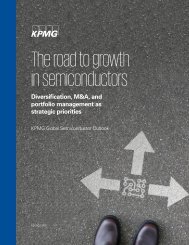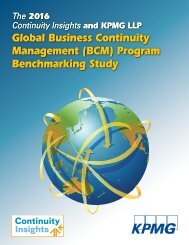Revenue for Telecoms
2cdncba
2cdncba
You also want an ePaper? Increase the reach of your titles
YUMPU automatically turns print PDFs into web optimized ePapers that Google loves.
168 | <strong>Revenue</strong> <strong>for</strong> <strong>Telecoms</strong> – Issues In-Depth<br />
| 10 Indirect channel sales<br />
Observations<br />
Move away from a risk-and-reward approach<br />
Under the new standard, a telecom entity typically considers contract-specific<br />
factors to determine whether revenue should be recognized on sale into the<br />
distribution channel or whether the telecom entity should wait until the product is<br />
sold by the dealer to its customer.<br />
SEC SAB Topic 13<br />
[IAS 18.16, IE2(c), IE6]<br />
This assessment may differ from current IFRS and US GAAP as a result of the<br />
shift from a risk-and-reward approach to a transfer of control approach. However,<br />
consideration of whether the significant risks and rewards of ownership have<br />
been transferred is an indicator of the transfer of control under the new standard<br />
(see 6.1) and conclusions about when control of handsets has passed to the<br />
dealer or the end customer are generally expected to stay the same.<br />
10.1.2 Principal versus agent considerations<br />
Requirements of the new standard<br />
606-10-55-36 – 55-36A<br />
[IFRS 15.B34–B34A]<br />
When other parties are involved in providing goods or services to an entity’s<br />
customer, the entity determines whether the nature of its promise is a per<strong>for</strong>mance<br />
obligation to provide the specified goods or services itself, or to arrange <strong>for</strong> them<br />
to be provided by another party – i.e. whether it is a principal or an agent. This<br />
determination is made by identifying each specified good or service promised to the<br />
customer in the contract and evaluating whether the entity obtains control of the<br />
specified good or service be<strong>for</strong>e it is transferred to the customer.<br />
Because an entity evaluates whether it is a principal or an agent <strong>for</strong> each good or<br />
service to be transferred to the customer, it is possible <strong>for</strong> the entity to be a principal<br />
<strong>for</strong> one or more goods or services and an agent <strong>for</strong> others in the same contract.<br />
606-10-55-37 – 55-38<br />
[IFRS 15.B35–B36]<br />
An entity is a ‘principal’ if it controls the specified good or service that is promised to<br />
the customer be<strong>for</strong>e it is transferred to the customer.<br />
When another party is involved, an entity that is a principal obtains control of:<br />
– a good from another party that it then transfers to the customer;<br />
– a right to a service that will be per<strong>for</strong>med by another party, which gives the entity<br />
the ability to direct that party to provide the service on the entity’s behalf; or<br />
– a good or a service from another party that it combines with other goods or<br />
services to produce the specified good or service promised to the customer.<br />
If the entity is a principal, then revenue is recognized on a gross basis – corresponding<br />
to the consideration to which the entity expects to be entitled. If the entity is an<br />
agent, then revenue is recognized on a net basis – corresponding to any fee or<br />
commission to which the entity expects to be entitled. An entity’s fee or commission<br />
might be the net amount of consideration that the entity retains after paying other<br />
parties (see 10.3).<br />
Home<br />
© 2016 KPMG LLP, a Delaware limited liability partnership and the US member firm of the KPMG network of<br />
independent member firms affiliated with KPMG International Cooperative, a Swiss entity. All rights reserved.<br />
© 2016 KPMG IFRG Limited, a UK company, limited by guarantee. All rights reserved.







